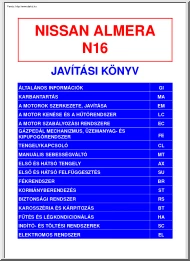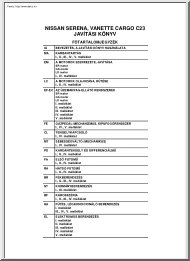Alapadatok
Év, oldalszám:2022, 2 oldal
Nyelv:angol
Letöltések száma:2
Feltöltve:2022. október 06.
Méret:831 KB
Intézmény:
-
Megjegyzés:
Csatolmány:-
Letöltés PDF-ben:Kérlek jelentkezz be!
Értékelések
Nincs még értékelés. Legyél Te az első!Legnépszerűbb doksik ebben a kategóriában
Tartalmi kivonat
How to Shift the Spicer PRO-SHIFT 18 Speed Transmission Fig. 1 Starting vehicle from a stop 1. (a) With the gear shift lever in neutral, (b) Clutch pedal depressed, (c) And brakes set, (d) Start the engine. Allow it to build to maximum air pressure. Starting in 1st Gear 2. (a) With the clutch pedal fully depressed to engage the clutch brake (see “Clutch Brake”) (b) Position the range and splitter selector to low. Move the gear shift lever into 1st gear position. Fig. 2 4. Normal shift sequence is shown in the shift pattern (Figure 1). When the lever is moved, use normal double clutch techniques. When a shift is desired, depress the clutch pedal and move the lever to neutral. Engage the clutch, allowing the engine to drop so engine and drive line speeds are matched. Depress the clutch pedal and move the lever into gear. Engage the clutch and accelerate as conditions permit 5. On splitter shifts, do not move the lever from its position With torque on the drive line,
merely push the splitter selector and use a single clutch application just enough to break torque. To let the engine speed drop Engage the clutch and apply the throttle. 6. When the shift requires both splitter and lever position change, select the splitter just as the shift lever enters neutral. Complete a normal double clutch operation The air shift will be completed automatically as the lever is moved to the next gear position. 7. The shifting from 10th to 11th gear requires a range change as well as a splitter change. The range selector can be preselected while the lever is still in the 5th stick position. The range change will only happen in neutral and it is synchronized. The splitter change (to low) and the lever change to the 2nd stick position requires the same as described above in point 6. 8. WARNING The splitter selector should not be changed without following a breaking of the torque applied to the transmission (push in the clutch) – preselection will wear the splitter
parts. The range selector can be preselected Downshifting Downshifting is actually just the reverse of upshifting. (see “Double Clutching: Downshifting”). Clutch Brake 3. (a) Release the trucks parking brakes and trailer parking brakes where applicable. (b) Release the clutch pedal gradually to full position. (c) Depress the throttle to start the vehicle moving. The clutch brake used with this unit is designed for stopping gear rotations so you can shift into 1st and reverse gears. The last one inch of clutch pedal travel activates the clutch brake. So on shifts other than 1st or reverse from a stop, only depress the clutch pedal enough to release the clutch. Depressing the pedal to the floorboard will activate the clutch brake and could cause gear hang-up or hard shifting. When selecting a starting gear, if you have a butttooth condition, gradually release the clutch so the drive gear can rotate to align the gear clutching teeth to complete the shift. Double Clutching
Reminders Upshifting: The normal double clutching technique is suggested. When you want to shift, depress the clutch and move the lever to neutral. Engage the clutch and allow the engine RPM to drop so engine speed and drive line speed match. Depress the clutch and move the lever into gear. Engage the clutch and accelerate as conditions permit. Downshifting: Downshifting is the reverse of upshifting. As the engine approaches the shift point (start the downshift approximately 50-100 RPM above the shift point), depress the clutch and move the lever to neutral. Engage the clutch and raise the engine RPM until the engine and drive line speeds are equal (normally, governed speed). Depress the clutch, then shift into the next low gear. Engage the clutch Skip Shifting Experienced drivers sometimes want to skip some of the ratios. This is acceptable However, you should do this only when operating conditions allow. Your speed, the load, and the road type and condition should be considered.
Double clutch when shifting. This will help components match speed better during shifts and will help ensure proper engagement. Downshift through all gear speeds when you are slowing down. Chassis and trailer brake life can be increased by doing this. Do not force the shift since this can cause damage to clutch collars and clutching teeth. Use steady force on the shift lever to complete shifts. Do not coast in neutral. The vehicle could lose RPMs during coasting and you may not be able to shift back into the proper gear. Do not downshift at road speeds that are too fast. This could prevent proper gear engagement and could damage clutching teeth. Do not tow vehicles without first pulling the axles or disconnecting the driveshaft. If you tow the vehicle without doing this, you can damage drive train components because the system lubrication is inadequate when the vehicle is towed. 14700 Helm Court Plymouth, MI 48170 (800) 401-9866 or (734) 456-3770 Fax: (734) 456-3739
www.ttcautomotivecom SPTD01601012
merely push the splitter selector and use a single clutch application just enough to break torque. To let the engine speed drop Engage the clutch and apply the throttle. 6. When the shift requires both splitter and lever position change, select the splitter just as the shift lever enters neutral. Complete a normal double clutch operation The air shift will be completed automatically as the lever is moved to the next gear position. 7. The shifting from 10th to 11th gear requires a range change as well as a splitter change. The range selector can be preselected while the lever is still in the 5th stick position. The range change will only happen in neutral and it is synchronized. The splitter change (to low) and the lever change to the 2nd stick position requires the same as described above in point 6. 8. WARNING The splitter selector should not be changed without following a breaking of the torque applied to the transmission (push in the clutch) – preselection will wear the splitter
parts. The range selector can be preselected Downshifting Downshifting is actually just the reverse of upshifting. (see “Double Clutching: Downshifting”). Clutch Brake 3. (a) Release the trucks parking brakes and trailer parking brakes where applicable. (b) Release the clutch pedal gradually to full position. (c) Depress the throttle to start the vehicle moving. The clutch brake used with this unit is designed for stopping gear rotations so you can shift into 1st and reverse gears. The last one inch of clutch pedal travel activates the clutch brake. So on shifts other than 1st or reverse from a stop, only depress the clutch pedal enough to release the clutch. Depressing the pedal to the floorboard will activate the clutch brake and could cause gear hang-up or hard shifting. When selecting a starting gear, if you have a butttooth condition, gradually release the clutch so the drive gear can rotate to align the gear clutching teeth to complete the shift. Double Clutching
Reminders Upshifting: The normal double clutching technique is suggested. When you want to shift, depress the clutch and move the lever to neutral. Engage the clutch and allow the engine RPM to drop so engine speed and drive line speed match. Depress the clutch and move the lever into gear. Engage the clutch and accelerate as conditions permit. Downshifting: Downshifting is the reverse of upshifting. As the engine approaches the shift point (start the downshift approximately 50-100 RPM above the shift point), depress the clutch and move the lever to neutral. Engage the clutch and raise the engine RPM until the engine and drive line speeds are equal (normally, governed speed). Depress the clutch, then shift into the next low gear. Engage the clutch Skip Shifting Experienced drivers sometimes want to skip some of the ratios. This is acceptable However, you should do this only when operating conditions allow. Your speed, the load, and the road type and condition should be considered.
Double clutch when shifting. This will help components match speed better during shifts and will help ensure proper engagement. Downshift through all gear speeds when you are slowing down. Chassis and trailer brake life can be increased by doing this. Do not force the shift since this can cause damage to clutch collars and clutching teeth. Use steady force on the shift lever to complete shifts. Do not coast in neutral. The vehicle could lose RPMs during coasting and you may not be able to shift back into the proper gear. Do not downshift at road speeds that are too fast. This could prevent proper gear engagement and could damage clutching teeth. Do not tow vehicles without first pulling the axles or disconnecting the driveshaft. If you tow the vehicle without doing this, you can damage drive train components because the system lubrication is inadequate when the vehicle is towed. 14700 Helm Court Plymouth, MI 48170 (800) 401-9866 or (734) 456-3770 Fax: (734) 456-3739
www.ttcautomotivecom SPTD01601012





